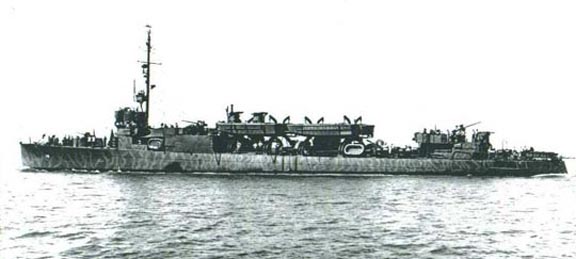 |
 |
| USS Schley (DD-103 / APD-14) |
| Technical Data: Built by Union Iron Works of San Francisco, California, the destroyer USS Schley was launched March 28, 1918 |
| and commissioned on September 20, 1918. Named after Rear Admiral Winfield Scott Schley (1839-1911), the USS Schley stretched |
| 314 feet, four inches in length and had a beam of thirty feet, eleven inches. Displacing 1,185 tons, she had a draft of nine feet, two |
| inches. Her twin-screw geared turbines put out 26,000 horsepower and reached a top speed of 35.2 knots. She held a crew of 133. |
| World War I: Under Commander R. C. Giffin, the Schley left San Diego, California, October 10, 1918, en route to the east coast. On |
| November 12, she departed New York for the Mediterranean, making port in Taranto, Italy, and Constantinople (today Istanbul), Turkey, |
| before arriving at Pola, Italy, on February 17, 1919, to begin duty as station ship in the Adriatic. Beginning April 15, she toured Italian |
| and Yugoslav ports on the Adriatic before departing for the United States on July 2. The Schley returned to San Diego on September |
| 8, 1919, and remained there until placed out of commission on June 1, 1922. |
|
Service in World War II: With war threatening, the Schley was recalled from reserve status and re-commissioned at San Diego on |
|
October 3, 1940. On December 17, she arrived in Hawaii for patrols and exercises. When Japanese planes attacked Pearl Harbor on |
|
the morning of December 7, 1941, the Schley was moored in dry dock among several other ships undergoing overhaul. As her guns |
|
were disassembled, she could only respond with small arms fire. Her repairs were expedited, and she headed to sea December 20, |
| taking up a patrol station off the channel entrance to Pearl Harbor. For the next year, she operated in those waters, as well as off the |
| coast of Honolulu. On December 13, 1942, the Schley returned to Puget Sound Navy Yard in Washington state for conversion to a |
| high-speed transport and was given the new designation APD-14. The Schley returned to Hawaii on February 22 and continued on to |
| the New Hebrides, arriving there March 24. In the New Hebrides, the Schley trained extensively with U.S. Marines, performed patrols |
| and escorts, and operated as a transport between the Solomon Islands, the New Hebrides, American Samoa, and New Zealand. On |
| June 30, the Schley participated in its first combat landing at New Georgia, putting troops ashore at Wickham Anchorage at the |
| southwest end of Vangunu. On July 5, Schley landed a second group of troops at Rice Anchorage, New Georgia. During this action, |
| a Japanese submarine sank the Schley's sister APD, the USS Strong, with a single, long-range torpedo shot. After returning to Rice |
| Anchorage with supplies and ammunition, the Schley departed on August 1 for Mare Island, California, for complete overhaul. The |
| ship returned to action and earned eleven World War II battle stars before being taken out of service in November 1945; however, this |
| narrative ends here, as Chief Plummer disembarked the Schley September 30 and transferred to a new ship then under construction. |
| Charley Plummer's Story: The above narrative captures the essence of the USS Schley's early World War II service. For a sailor's |
| view, click here and read Chief Quartermaster Charley Plummer's own words describing daily activities of July 1940 through October |
| 1943, carefully transcribed from a small pocket diary he maintained during his many years at sea. |
| Ship's Itinerary (from Chief Quartermaster Charley Madison Plummer's diary): click here. |
|
Sources: Dictionary of American Naval Fighting Ships; wartime diary of Chief Quartermaster Charley M. Plummer, U.S. Navy (1920-50). |
|
|